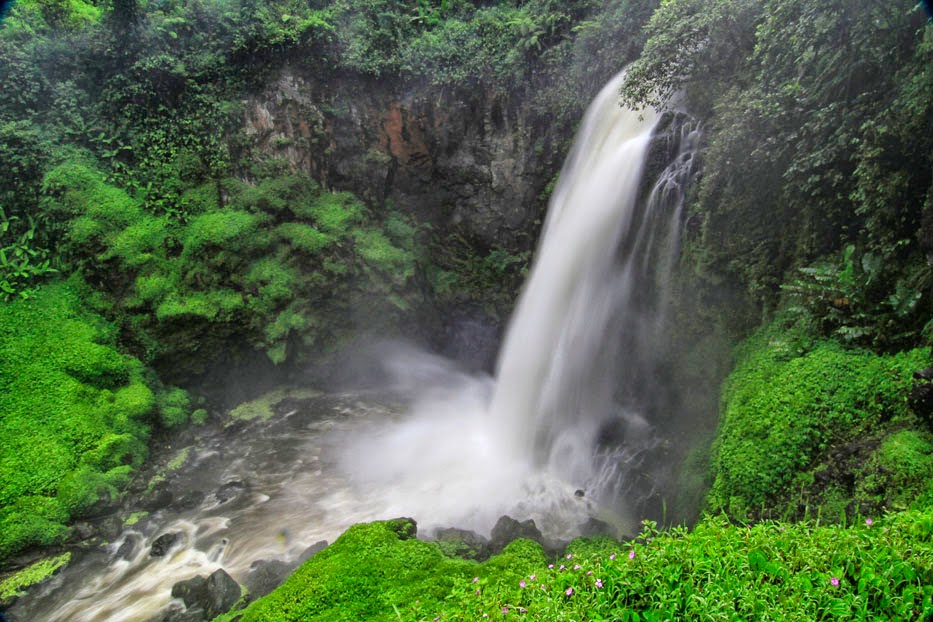Overview
Deep within the Telun Seblat National Park, neatly concealed behind a
tangle of thick foliage, the sounds of roaring waters splashing over
rocks can be heard. After a laborious yet rewarding climb up Mount
Kerinci, or perhaps a leisurely stroll through the Kayu Aro tea
plantations,Telun Smoky Falls is the decoration atop the cake, or the
final step in a perfect adventure through the Kerinci Regency in Jambi
Province. As with many waterfalls, Telun Smoky Falls was created by
erosion, through the process of fast flowing waters passing through a
large rock formation. Telun Smokey Falls, however, retains its own
distinct allure.
The waters of Telun Smokey Falls begin at Lake Gunung Tujuh, or Lake Of Seven Mountains. The streams then pass through steep rifts and ravines amidst rocks and boulders before crashing down from a height of approximately 50 meters into the rocky pool below. The sheer height of the waterfall causes the fallen droplets to create a sort of mist around the falls, hence giving it its name: Smoky Falls. The suspended fog of water in turn allows the refraction of passing light, producing a spectacle of colorful rainbows projected across the waterfall as well as the pool below. A cave is hidden behind the curtain of raging water, but till now no one has been able to enter.
The waters of Telun Smokey Falls begin at Lake Gunung Tujuh, or Lake Of Seven Mountains. The streams then pass through steep rifts and ravines amidst rocks and boulders before crashing down from a height of approximately 50 meters into the rocky pool below. The sheer height of the waterfall causes the fallen droplets to create a sort of mist around the falls, hence giving it its name: Smoky Falls. The suspended fog of water in turn allows the refraction of passing light, producing a spectacle of colorful rainbows projected across the waterfall as well as the pool below. A cave is hidden behind the curtain of raging water, but till now no one has been able to enter.
The trek to the Telun Smokey Falls is quite a challenge and involves a
300 meter uphill trek from Telun Berasap Village. Steps lead the way to
the falls, but can become slippery in the case of rain. Despite the
possibly arduous journey, depending on your level of fitness, the trek
through the magnificent tropical landscapes of TelunSeblat National Park
is not one to be missed. The path is bordered on either side by
majestic and towering trees which locals say are hundreds or even
thousands of years old. The park is also home to nearly 400 species of
bird and is said to be habitat to more tigers than China, Laos, Cambodia
and Vietnam combined.
Small wooden lodges are set around the falls for visitors to relax after a tiring trek and enjoy the dazzling view. Take a dip in the sparkling cool waters or test your skill at scaling the rocks around. Visitors should be advised not to attempt diving, however, as the pool at the foot of the falls is fairly rocky.
Small wooden lodges are set around the falls for visitors to relax after a tiring trek and enjoy the dazzling view. Take a dip in the sparkling cool waters or test your skill at scaling the rocks around. Visitors should be advised not to attempt diving, however, as the pool at the foot of the falls is fairly rocky.
Get There
The two closest cities to Sungai Penuh, capital city of Kerinci Regency, are Jambi and Padang.
Getting to Sungai Penuh from Jambi city takes about 10 hours by car over a distance of approximately 500 km. This can be done using public transportation or rental car. Jambi airport serves just Jakarta and Batam.
The alternative route through Padang is much faster, at a total distance of under 300 kilometers. Sungai Penuh can be reached via public transport, car rental or private car. Minangkabau International Airport in Padang serves Jakarta, Medan, Pekanbaru, Batam and Kuala Lumpur.
Getting to Sungai Penuh from Jambi city takes about 10 hours by car over a distance of approximately 500 km. This can be done using public transportation or rental car. Jambi airport serves just Jakarta and Batam.
The alternative route through Padang is much faster, at a total distance of under 300 kilometers. Sungai Penuh can be reached via public transport, car rental or private car. Minangkabau International Airport in Padang serves Jakarta, Medan, Pekanbaru, Batam and Kuala Lumpur.
From Sungai Penuh Village, proceed about 60 km more to Telun Berasap
Village. This leg of the journey is best accomplished with the use of a
four-wheel drive. From Telun Berasap Village, you can continue on foot
to the falls.
To Stay
No accommodations are available in Telun Berasap village, so lodging is
best in Sungai Penuh, capital city of Kerinci District – but do not
expect to find any sort of luxury hotel. Budget hotels and guest houses
in Sungai Penuh are simple, but comfortable and provide friendly
service. Here are a few of the hotels in Sungai Penuh
Hotel Jaya
Jl. Re. Martadinata no. 22 Sungai Penuh.Tel. 0748-2122
Hotel Jaya
Jl. Re. Martadinata no. 22 Sungai Penuh.Tel. 0748-2122
To Eat
While in the Kerinci Regency , the local delights that are worth a try
are Bera Payo, GulaiIkan Semah, Denden Beteko and Kacang Tojin. For
coffee lovers, don’t forget to try Kerinci Coffee, and for tea drinkers,
of course the famous Kayu Aro Tea.

Using RentalCars you can find affordable car rentals from over 49,000 locations globally.
ReplyDelete